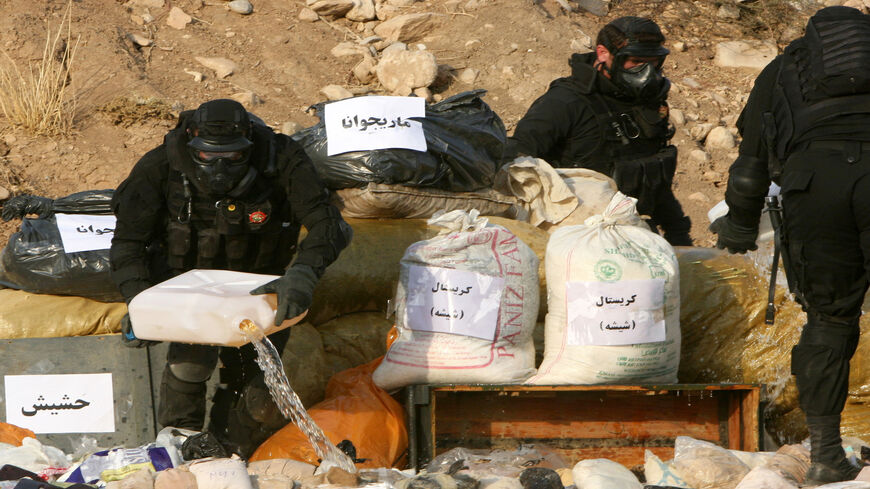ERBIL, Iraqi Kurdistan — In early December, the directorate tasked with drug control in Iraq’s Maysan province in the southeastern part of the country along the Iranian border urged that more detention facilities be built as soon as possible due to a sharp rise in the number of drug-related arrests and the inability to house all those arrested.
The problem, however, seems to extend across the entire country.
In late December, a hashtag began trending in Iraq that literally means “starve them” and implies “starving” armed groups and “[political] parties [linked to militias]” operating in Iraq that are involved in the drug trade and that use the proceeds to buy weapons and support, acting as de facto mafia-type organizations.
No specific “parties” are referred to but the same word was often used during the massive protests in late 2019 that brought down the government at the time to refer to Iran-linked groups.
In Iraq, methamphetamine use — and not only the smuggling of various drugs — has become more of a problem in recent years, several Iraqi sources close to and within the security forces have told Al-Monitor.
Iraq shares a long border with Iran, which has seen a surge in Afghans fleeing their home country after the Taliban took control in mid-August. A significant amount of the drugs trafficked through Iran has come from Afghanistan for many years.
The Norwegian Refugee Council reported Nov. 10 that between 4,000 and 5,000 Afghans were fleeing into Iran via informal border crossings on a daily basis, adding that “at least 300,000 Afghans” had entered since the Taliban takeover.
This indicates scant border control and a consequent likelihood of increased drug smuggling as well, especially amid the dire economic situation in Afghanistan following the US pullout.
A European Monitoring Center for Drugs and Drug Addiction report published in November 2020 noted, “An important innovation over the last three years has been the diversification into the production and processing of significant quantities of ephedrine and methamphetamine by rural households in the southwest [of Afghanistan]."
David Mansfield, an expert on opium poppy cultivation in Afghanistan, noted in a Dec. 3 tweet that imagery analysis “supports reports from the ground and shows a growing capacity for ephedrine production, with a 34% increase in the number of ephedrine labs identified over the last year,” stressing that the labs “that were already there appear to be producing more.”
Meanwhile, on Iraq’s western border, the captagon drug trade continues to flourish, according to local security sources this journalist has met with in person on multiple reporting trips to the border area in recent years.
Iraqi security forces backed by the international coalition retook Rawa, the last Islamic State-held town, in November 2017.
Anbar now sees fewer IS attacks than some of Iraq’s other provinces, such as Diyala, but the mostly desert Anbar province in the west of Iraq along the country’s border with Syria, Jordan and Saudi Arabia continues to act as a hideout for IS as well as drug traffickers.
Vast tracts of land in the province are under the control of Iran-linked armed groups, many of which have fighters in the government-incorporated Popular Mobilization Units (PMU) but openly state they are part of the Iran-led "Muqawama" ("resistance").
This journalist has repeatedly been refused access to areas under their control between Qaim and Rutbah, which is where much of the drug smuggling allegedly takes place.
Across the border in Syria, the Tanf garrison with the US-backed Syrian armed opposition group Jaysh Maghawir al-Thawra (MaT) has often stopped attempts to smuggle large amounts of captagon.
MaT commander Mohannad al-Talaa told Al-Monitor on Dec. 25, "[Tanf] is an important border area as it is located on the border triangle between Syria, Jordan and Iraq, and it is the link between areas of the country under the [Syrian] regime and the Arab Gulf states through Jordan and Iraq.”
The Tanf garrison is a military base within territory controlled by Syrian opposition groups in the eastern part of Homs province south of Deir ez-Zor in the desert. A significant US military presence was known to be there beginning in early 2016. The international coalition continues to support MaT.
MaT does not work with the Kurdish-led Syrian Democratic Forces (SDF), also supported by the international coalition, which control significant territory in northeastern Syria. Territory controlled by the Syrian government and Iran-linked militias lies between MaT and SDF territory.
The deconfliction zone surrounding the Tanf garrison borders both Iraq and Jordan. The key M2 Baghdad-Damascus highway runs through it and the Rukban internally displaced persons camp is inside the zone.
Talaa stressed that an Oct. 20 attack on the Tanf garrison by drones originating from Syrian government-held areas had “targeted the homes of MaT families” and that the garrison and MaT constitute a “major obstacle” to the “Iranian expansionist project.”
He noted, “The Lebanese Hezbollah exploit Syrian territory for the cultivation of narcotics and their production, [and this has] become an important source of income for it in its war against the Syrian population.”
The involvement of the Syrian government and Hezbollah in the regional trade of illicit substances including captagon has been amply corroborated by numerous studies in recent years.
The New York Times published an in-depth report Dec. 5 stating, “An illegal drug industry run by powerful associates and relatives of President Bashar al-Assad has grown into a multibillion-dollar operation, eclipsing Syria’s legal exports and turning the country into the world’s newest narcostate.”
Talaa said that the latest of many smuggling attempts that MaT had played a part in thwarting was Dec. 2.
In 2018, Talaa had told this journalist that two smugglers — an Iraqi and a Syrian — had been caught by the group with an estimated $1.4 million in narcotics in May of that year.
Over three years later, drug smuggling and use continue and appear to be increasing across Iraq.






